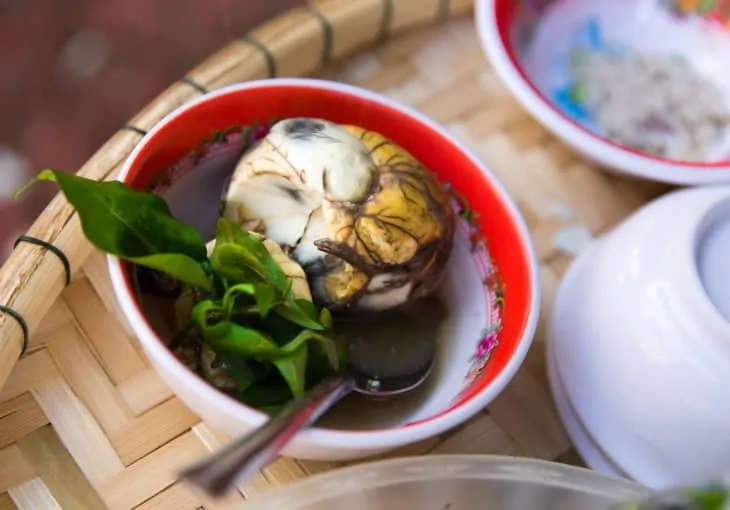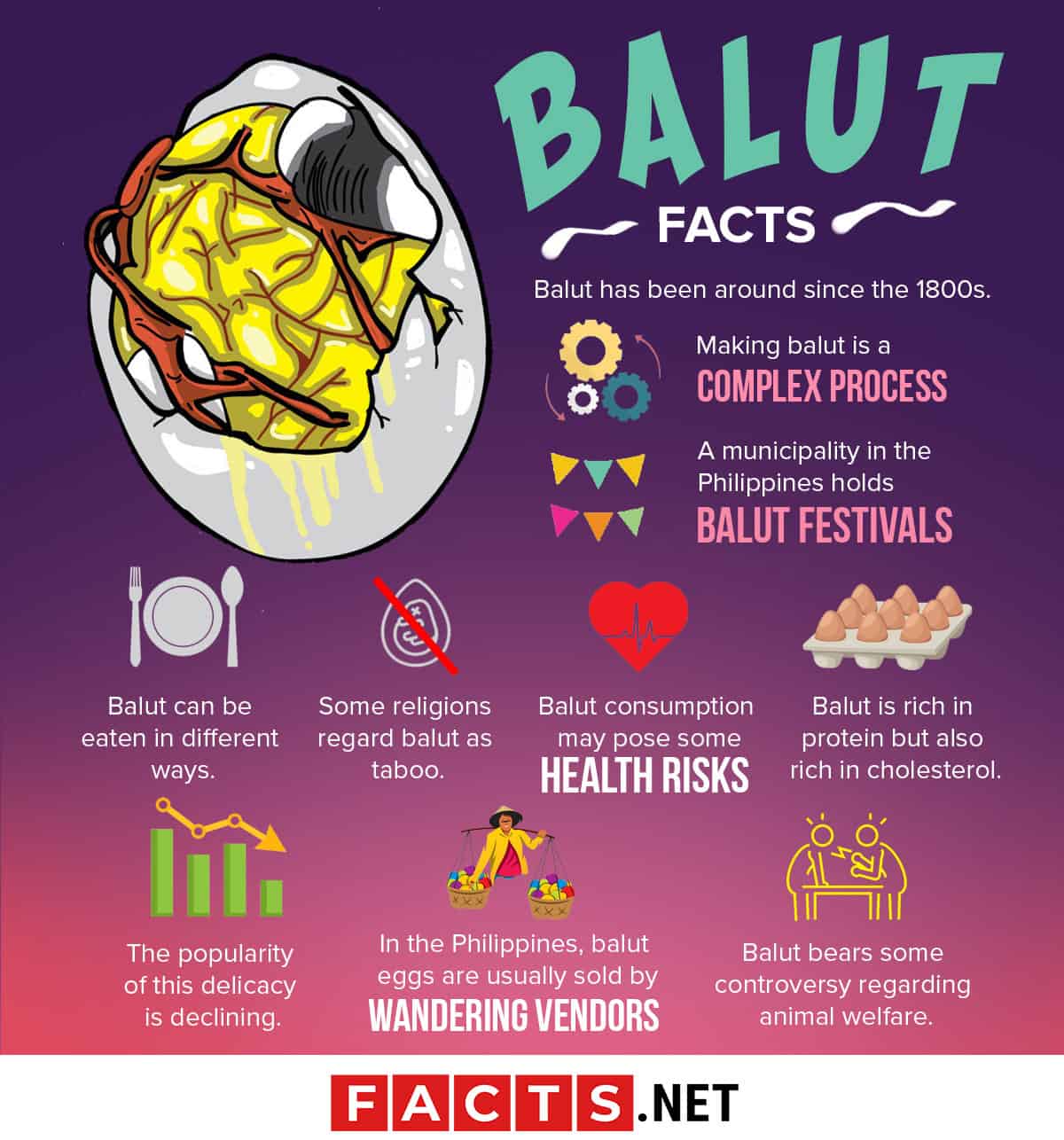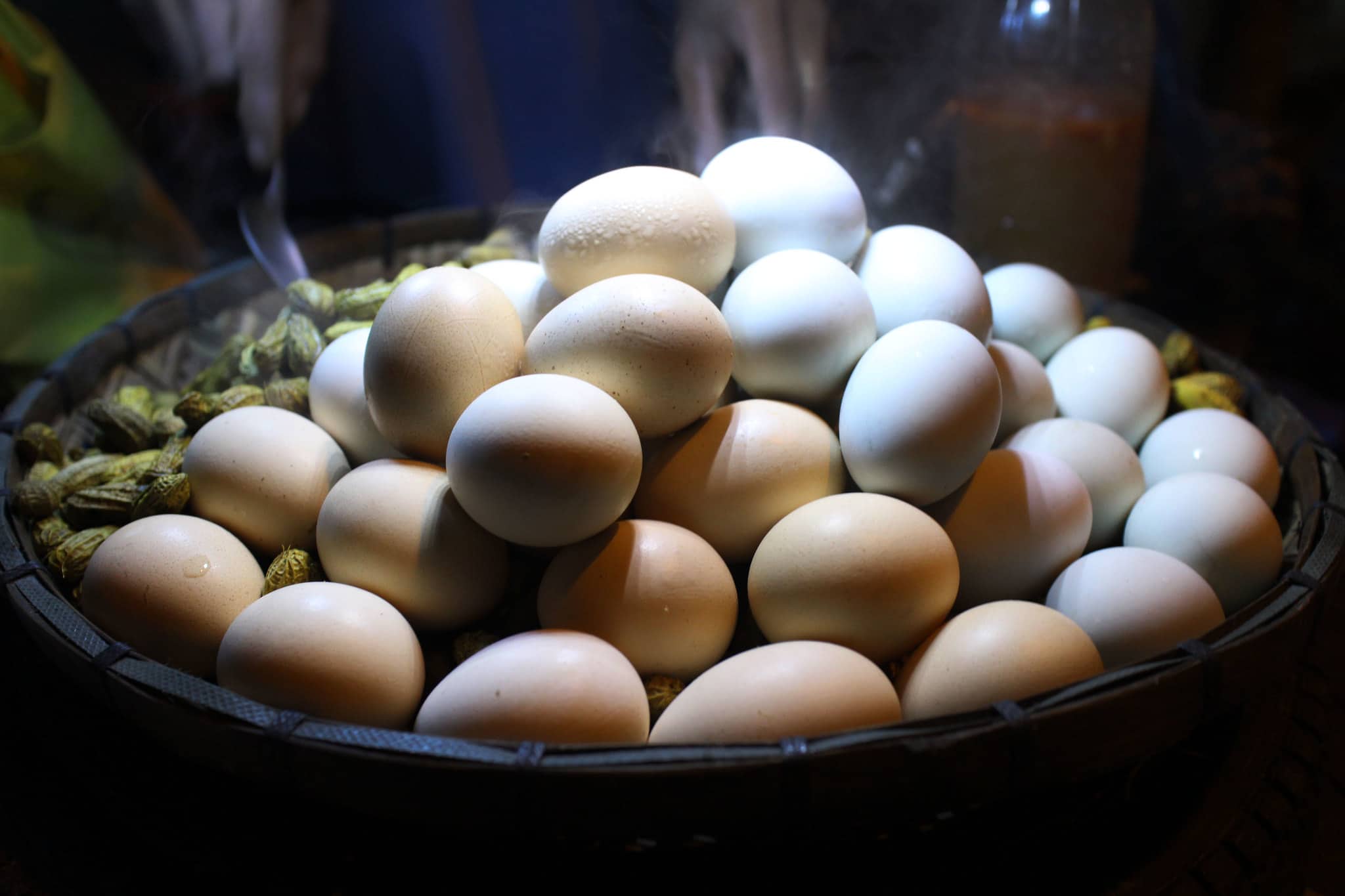
Balut, or fertilized duck egg, is a controversial delicacy that just seems bizarre to unfamiliar lookers. Adventurous eaters seek out this infamous food item, and it’s not for the faint of heart. Within the egg lies a watery broth, a veiny yolk, and a developing duck embryo covered in feathers. Sometimes it has prominent duck features! The sight alone is enough to terrify unwitting onlookers, but it remains a well-loved snack in many parts of Southeast Asia. Most notably, it’s a widely popular type of Asian street food in the Philippines. So get to know more about this bizarre food with these balut facts.
- Balut has 188 calories.
- The eggs are typically incubated for 14-21 days.
- It has 2 mg of iron.
- Balut has 116 mg of calcium.
- Center for Culinary Arts and the Municipality of Pateros in the Philippines prepared the he largest serving of balut. It was 117.5 kg (259.04 lb).
- Balut contains a developing duck embryo, yolk, and hardened egg whites.
- Duck eggs are commonly used to make this delicacy, but balut made with chicken eggs are also available in the market.
- Because of its rather unsettling nature, many reality television shows feature this delicacy as a challenge item.
- Some cultures believe that eating balut is proof of someone’s toughness and masculinity.
- Pregnant or delivering women in Vietnam eat balut for its reported nutritious and restorative properties.
- Various ethnic groups in the Philippines,such as the Mankayan Kankana-eys and Kalingas of Tabuk prohibit pregnant women from consuming this dish because they believe that it may cause deformities in the unborn child.
- This delicacy is the primary product of the Philippines’ duck farming industry.
- Balut’s name has a few variations in the Philippines, such as balot or balut sa puti.
- Its name stems from the Filipino term balut sa puti, which means “wrapped in white”.
- Outside of Southeast Asia, the delicacy can be found in Filipino specialty stores.
- There are balut-eating contests in New York City.
- Many regard the balut egg as a natural aphrodisiac, but this property has not been studied scientifically.
- Canada considers this delicacy a hazardous food.
- There is a Yahtzee-like dice game named Balut, which takes its name after this delicacy.
- Canada does not consider balut as egg products and therefore are not subject to their egg regulations.
Balut Facts Infographics

Balut has been around since the 1800s.
Although the Philippines largely popularized this fertilized egg delicacy, the Chinese introduced it to the Philippines around the year 1885. Experts gathered that the Chinese developed these fertilized egg treats as a way of extending the shelf life of the eggs before the advent of modern refrigerators. The Chinese called it “maodan”, which translates to “feathered egg”, referring to the fact that the duck embryos inside had visible feathers.
The delicacy then gained popularity as an inexpensive and easy source of protein for the working class. As Filipinos migrated to different countries, some of them upheld the tradition of making balut and popularized it in various countries in Southeast Asia, such as Cambodia, Laos, Thailand, and Vietnam.

Making balut is a complex process.
Magbabaluts make baluts by incubating fertilized duck or chicken eggs until the embryos start to form and develop. They incubate the eggs in baskets filled with warm sand or placed under the sun. The conditions must be ideal, because temperature changes can affect the outcome of the eggs. If the temperature is too cold, the embryo may not develop. On the other hand, it may die if the temperature is too hot.
Magbabaluts check the contents of the eggs after seven to nine days of incubation by holding them against a light source. They will cook the undeveloped eggs and sell them as a different product, which is penoy. Penoy is highly similar to regular hard-boiled eggs.
The length of incubation varies by country, and the features of the duck embryo become more pronounced as the number of days increases. Filipinos prefer to incubate it for 14 to 18 days before cooking. Cambodians, who refer to this dish as pong tia koun, prefer to incubate it for 17 to 20 days. In Vietnam, where it is called trứng vịt lộn, the eggs are incubated for 19 to 21 days, wherein the embryos are already firm when cooked. The bones and beak may be pronounced but tender when cooked.
Once the eggs reach the desired period of incubation, balut-makers will cook them by boiling them in water for about 20 to 30 minutes. Although it undergoes boiling similar to typical hard-boiled eggs, the contents undergo unique chemical reactions. The liquids in the egg will become a watery broth, and the egg whites will become solid and rubbery. The yolk will be custard-like, rich, and creamy, and of course, the duck embryo will be tender.
A municipality in the Philippines holds balut festivals.
The municipality of Pateros in Metro Manila is the “Balut Capital” of the Philippines. Pateros has a prosperous duck-farming and balut-producing industry, which is apt because the municipality’s name translates to “duck-raiser”. Every year, Pateros holds a festival dedicated to baluts, which they call the “Balut sa Puti festival”. The Balut sa Puti festival revolves around the municipality’s quality baluts, and it also features festivities such as live music, dancing, and cooking competitions.
Balut can be eaten in different ways.

Balut is popular in the Philippines as a tasty snack, perhaps after work or late at night after a few drinks. Typically, Filipino balut-eaters consume them warm and right off the shell. They crack the eggs open and sip the broth inside. Afterwards, they season the contents of the eggs with salt or vinegar with chili and/or garlic. All of the contents inside are edible, but the egg whites may be tough and rubbery depending on the age of the egg. Filipinos call this part bato, or “stone”, and often discard it.
Cambodians also eat baluts with minimal amounts of garnish, often just pepper and a bit of lime juice. Vietnamese balut-eaters may prefer to eat it with pepper salt with ginger, as well as laksa leaf (rau răm).
Aside from the traditional ways of eating it, balut also rose to prominence in haute cuisine. Restaurants may serve balut as appetizers, cooked in different styles such as omelette, adobo, or as pastry fillings.
In the Philippines, balut eggs are usually sold by wandering vendors.
Whether it’s late in the afternoon or a few hours before daybreak, balut vendors in the Philippines wander the streets and sell the eggs to passersby. It’s one of the most popular street foods in the country. These magbabaluts or mangbabalots shout a highly recognizable “Baluuuuuut!” as they carry insulated baskets or buckets that store the eggs and keep them warm.
Balut bears some controversy regarding animal welfare.
There are many debates about the ethical matters surrounding its consumption, as some may find it appalling to boil and consume partially-developed chicks. The duck or chicken embryos in balut are about a week short of hatching and already have the neural networks necessary to feel pain, and animal welfare advocates contest that boiling them is therefore inhumane.
Some religions regard balut as taboo.
Judaism and Islam both forbid the consumption of this delicacy because of its nature and methods of preparation. These religions hold strict laws regarding food. Judaism forbids the consumption of embryos inside bird eggs even if the bird is kosher. Islam, on the other hand, says that balut is taboo because the animal has not been slaughtered properly. Some Christians also forbid the eating of balut because they believe that animals’ blood should be poured upon the ground to be fit for consumption.
Balut consumption may pose some health risks.
Health considerations regarding balut are also quite controversial. Although the consumption of balut has not caused any known outbreaks, some food safety authorities deem balut unsafe. This is because the incubation temperatures and environment that many balut-makers utilize actually make it ideal for certain bacteria to grow, such as Salmonella enteritidis. Furthermore, the eggs, especially if sold raw, may also have some fecal material on their surface from the egg-laying process. Authorities therefore recommend that consumers proceed with caution and only get balut from trusted sources.
Balut is rich in protein but also rich in cholesterol.

Because it’s cheap, readily available, and nutritious, many regard balut as a one-of-a-kind snack and even liken it to a power bar. The eggs provide a multitude of essential nutrients such as vitamin C, beta-carotene, thiamine, iron, and calcium, among many others. It contains 188 calories, and this unusual treat also packs an impressive 14 grams of crude protein.
This uncanny but nutritious food has a catch, however, and it’s the cholesterol content. One yolk of a fertilized duck egg alone contains about 359 mg of cholesterol, which exceeds the FDA’s recommended daily cholesterol intake of 300 mg. Although cholesterol is an important part of your diet, too much can lead to cardiovascular disease. Quite literally, balut is not for the faint of heart.
The popularity of this delicacy is declining.
Although still widely loved among many Southeast Asians, balut is decreasing in popularity. In the Philippines, there is a significant drop in demand for baluts. Experts attribute this to Filipinos’ rising exposure to Western cuisine, as well as its association with poverty. Moreover, increasingly polluted rivers also affect the duck-farming industry.
Was this page helpful?
Our commitment to delivering trustworthy and engaging content is at the heart of what we do. Each fact on our site is contributed by real users like you, bringing a wealth of diverse insights and information. To ensure the highest standards of accuracy and reliability, our dedicated editors meticulously review each submission. This process guarantees that the facts we share are not only fascinating but also credible. Trust in our commitment to quality and authenticity as you explore and learn with us.


